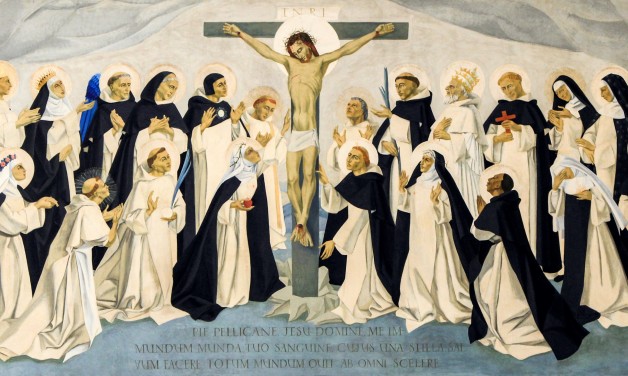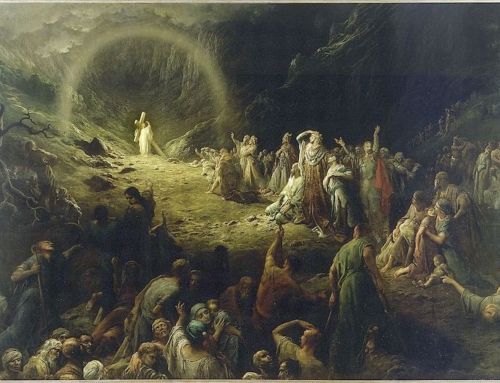Today the Dominican Order celebrates the feast of St. Catherine de Ricci. She’s known for her mysticism and her devotion, as found in her Canticum de Passione Domini. The studentate has translated and recorded the chant for you.
[soundcloud url=”https://api.soundcloud.com/tracks/223240591″ params=”color=ff5500&auto_play=false&hide_related=false&show_comments=true&show_user=true&show_reposts=false” width=”100%” height=”166″ iframe=”true” /]
The Canticum de Passione Domini consists of two-line verses from Scripture, both from the Old and New Testaments, which a solo cantor chants in Gregorian mode II while kneeling before the crucifix. The solemn, sorrowful melody pulses like the heavy breathing of the dying Christ, and the silence between verses hangs with the gravity of Calvary. The span of time that passes between the verses communicates the reality that God inspired the words of David, always knowing that Christ’s crucifixion would fulfill them. As God was granting the Israelites their kingdom and building the temple, He was also announcing that He, the true King and Temple, would be torn down.
Yet, Christians know that what was torn down was rebuilt in three days. Friday is perfected by Sunday. Those who die with Christ also rise with Him. From the moment of Baptism we are taken up into the Body of Christ. We begin to live like St. Paul who says, “And I live, now not I; but Christ liveth in me” (Gal 2:20).
Christ’s presence within St. Paul was so profound that Paul bear[s] the marks of the Lord Jesus in [his] body (Gal 6:17). He is possibly the first saint of the Church to bear the stigmata. Another popular account of the stigmata is that of the Dominican St. Catherine of Siena, but less known are the wounds of her religious sister St. Catherine de Ricci.
There’s an interesting relationship between the two Dominican saints. They share the same name, the same mystical visions, and the same wounds. Look for a painting of St. Catherine de Ricci and try to distinguish her from St. Catherine of Siena. They almost seem to be the same person. This is because both women had a devotion to Christ crucified. Just as Christ was joined to the cross with His wounds, so too these saintly women were joined to Jesus by His wounds. It was de Ricci’s love and union with Christ Crucified that led her to compose the devotion we shared above.
The divine favors that both Catherines received announce the presence of Christ, suffering in His Body the Church. While you or I will likely never encounter such miracles, the reality of Christ’s presence within His faithful people should not be overlooked. It should be seen through the eyes of faith. The baptized are taken up into Christ and adjured to offer their bodies as a living sacrifice. By this, the sufferings of this world are no longer meaningless. God has taken on our sufferings and transformed them into the bridge that connects man to God.
Those who mocked Christ on the Cross, beckoning Him to come down, were ignorant of what was being accomplished – His life was not being taken, but He was laying it down for His friends. What kept Jesus on the Cross was not the nails, but His love. No one else possesses the power to choose his or her own afflictions; we are passive in suffering. Yet, the baptized can join St. Catherine’s example. She meditated on the Passion of Our Lord not because it was something that happened in the past, but it was an event that pervaded time, up to her present and up to our present. Christ continues to suffer in His members. Those in the Church, who unite their sufferings to His wounds, are brought up into something greater than themselves.
Pope Benedict explains,
This liberation of our “I”… means finding oneself within the vastness of God and being drawn into a life. . . . [By the Resurrection] we are associated with a new dimension of life into which, amid the tribulations of our day, we are already in some way introduced. . . . This is the meaning of being baptized, of being Christian.
St. Paul’s own words, “It is no longer I who live, but Christ who lives within me,” were taken up again by St. Catherine of Siena and St. Catherine de Ricci, marking their own lives. Their similarity of life, their union in the wounds of Christ, bear great witness to the living reality of Jesus in His mystical Body, the Church. They also beckon us all to look to the Passion in prayer. Then, seeing what Christ did two thousand years ago, we can see what Jesus continues to do within us.
✠
Image: Sr. Mary of the Compassion, O.P., St. Dominic and Saints







